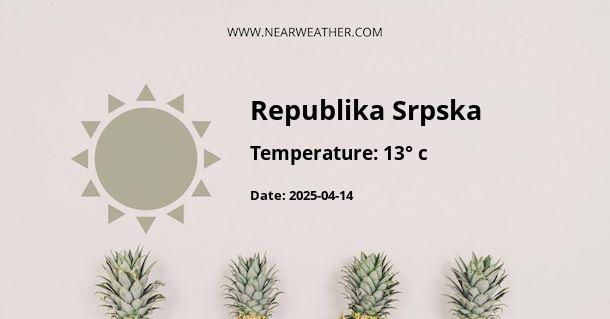Climate and Weather of Republika Srpska, Bosnia and Herzegovina
The climate of Republika Srpska, a political entity within Bosnia and Herzegovina, exhibits significant variety due to its complex topography and geographical position in southeastern Europe. This region experiences a diverse climate that ranges from continental in the north to Mediterranean in the south. In this detailed overview of Republika Srpska's climate, we'll explore how weather patterns are influenced throughout the year by factors such as altitude, latitude, and proximity to the Adriatic Sea.
General Climate Overview
Republika Srpska straddles the climatic divide between the moderate continental and Mediterranean climates. The northern parts encounter continental influences, experiencing hot summers and cold, snowy winters, while the southern regions often have milder winters and hotter, drier summers owing to Mediterranean influences.
| Region | Climate Type | Summer Avg. Temp (°C) | Winter Avg. Temp (°C) | Precipitation Patterns |
|---|---|---|---|---|
| Northern Plains | Continental | 20-25 | -2-3 | Evenly distributed |
| Central Highlands | Modified Continental | 15-20 | -5-0 | Higher in spring and fall |
| Southern Region | Mediterranean | 25-30 | 5-10 | Maximal in autumn and winter |
Seasonal Weather Patterns
Spring
Spring in Republika Srpska is markedly unstable, with rapid shifts in temperature and weather conditions. The transitional nature of this season often results in substantial precipitation, particularly in the central highlands. Melting snow from the mountains contributes to increased river levels and potential flooding in lower lying areas.
Summer
Summer is characterized by warm to hot temperatures, particularly in the lowlands and the southern regions. It is not uncommon to experience heat waves, where temperatures can soar above 30°C. However, due to the diverse topography, summer temperatures can vary substantially with elevation.
"Summers in Republika Srpska offer a broad spectrum of temperatures, from mild highland breezes to the scorching sun of the south. It’s a period where the entire landscape comes to life with vivid colors and bustling outdoor activity." - Regional Climate Expert.
Fall
Fall sees a gradual cooling trend with increased precipitation. This is particularly true for the southern and central regions where the rainfall helps replenish water sources and contributes to the lush landscapes that characterize Republika Srpska's scenic beauty.
Winter
Winter is when the climate differences within Republika Srpska become most pronounced. The northern areas experience frigid conditions with potential heavy snowfall, which is advantageous for winter sports in ski resorts like Jahorina and Bjelašnica. Conversely, the southern region remains relatively temperate, with less severe winters.
Temperature and Precipitation Analysis
Temperatures throughout the year can vary significantly based on geographical location and altitude. Precipitation is generally distributed throughout the year, with certain locales receiving snowfall that can persist for several months, particularly in mountainous areas.
- Annual Temperature Range: Depending on the region, average annual temperatures can fluctuate widely, with a general range of -3°C to 10°C in January to 20°C to 30°C in July.
- Annual Precipitation: Rainfall varies but is frequently higher in the western parts influenced by the Dinaric Alps. Annual precipitation levels can range from 800 to 1,200 mm.
Climate Challenges and Environmental Concerns
In recent years, Republika Srpska has faced climate-related challenges, including increased instances of extreme weather events. Notably:
- Flooding, particularly in the north where river flooding can impact agriculture and settlements.
- Heatwaves, with a direct effect on human health, water supply, and increased fire risk, especially in the Mediterranean influenced regions.
- Winter storms and heavy snows, disrupting transportation and infrastructure, while also affecting the energy sector due to increased demand for heating.
Environmental concerns add another layer to the discussion on climate and weather. Issues such as air pollution in urban areas, deforestation, and water pollution are interlinked with climate patterns and human activity. Strategies to combat these challenges are integral to the ongoing environmental policy discussions within Republika Srpska and the broader region.
Conclusion
To sum up the climate and weather of Republika Srpska, it is evident that the region boasts significant climatic diversity, with profound implications for agriculture, water management, and daily life. Understanding this intricate meteorological tapestry is essential for residents, businesses, and policymakers alike, as they navigate the challenges and opportunities presented by the region's distinct weather patterns.
A - Republika Srpska's Latitude is 44.933331 & Longitude is 17.183331.
A - Weather in Republika Srpska is 18° today.
A - Climate Conditions in Republika Srpska shows clear sky today.
A - Humidity in Republika Srpska is 64% today.
A - Wind speed in Republika Srpska is 5.54 km/h, flowing at 30° wind direction. today.
